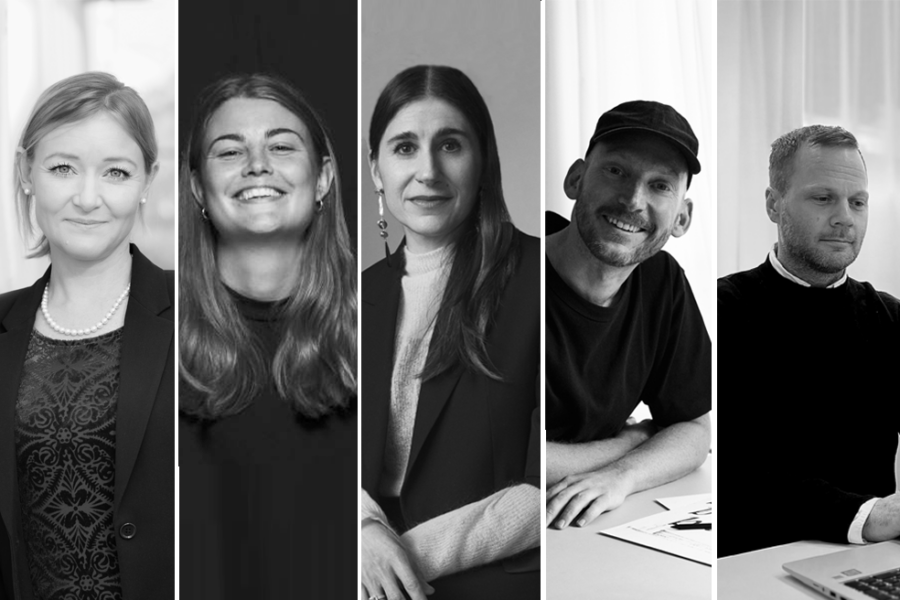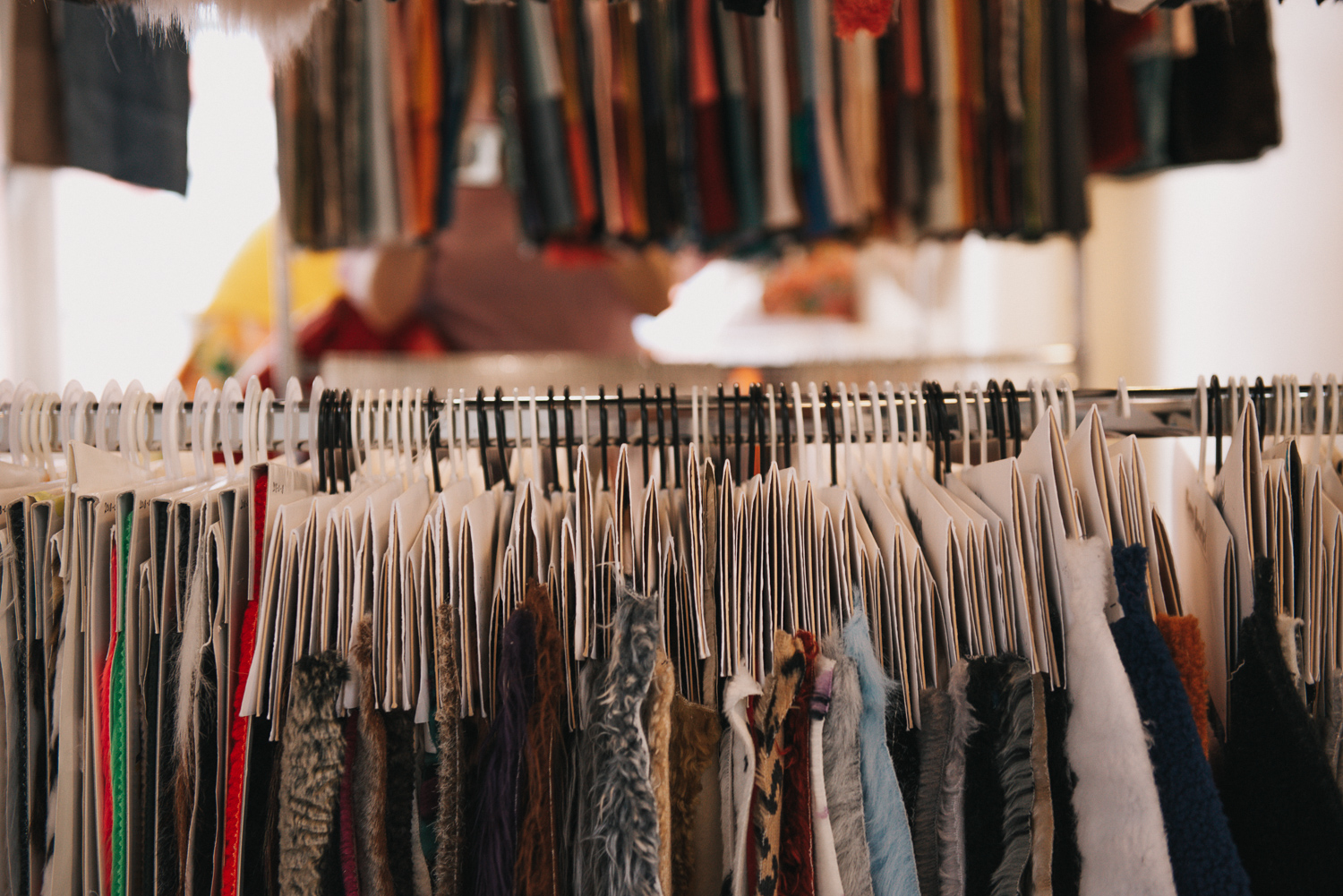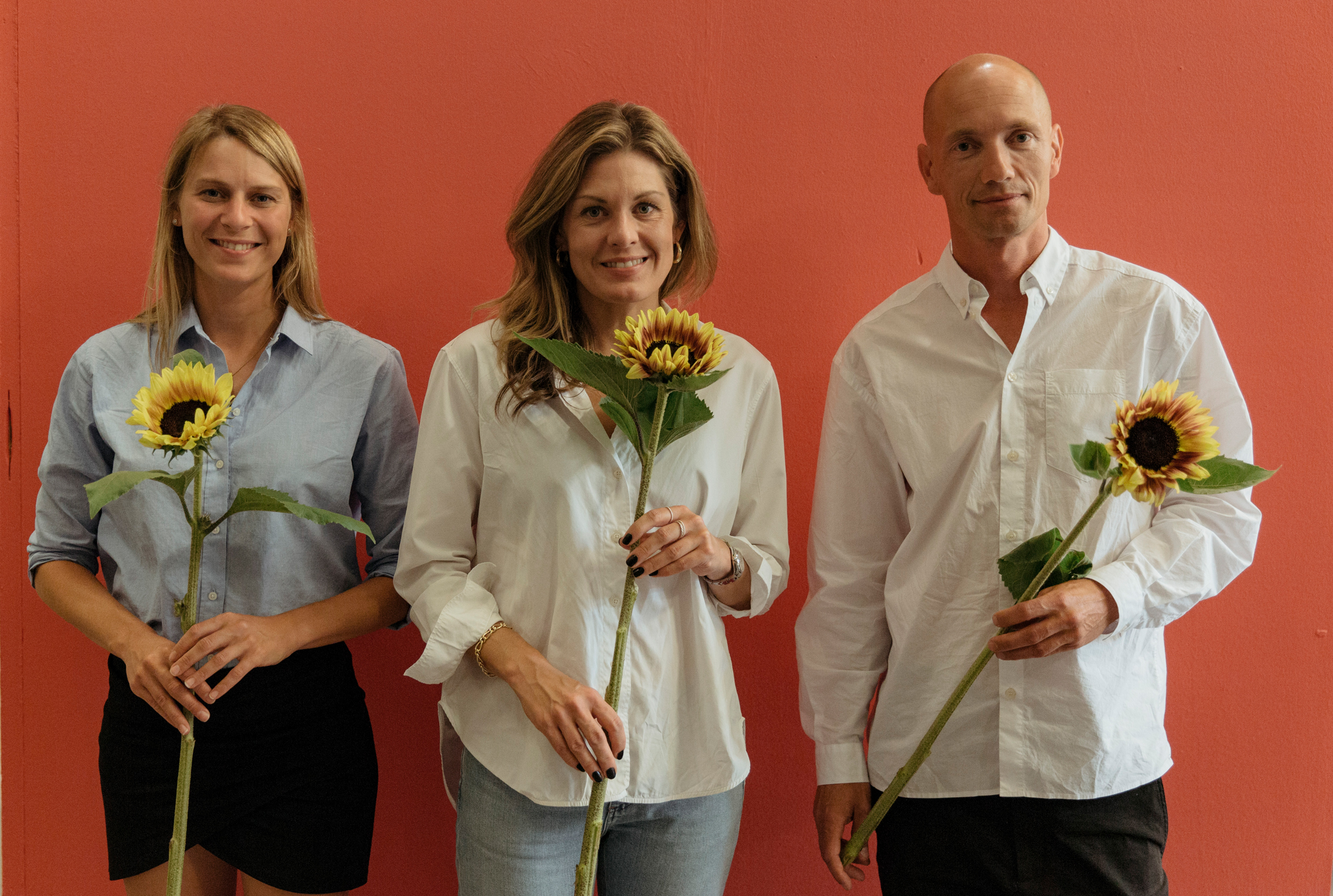
Sustainability in the fashion industry – the current state and future
We spoke to industry leaders and entrepreneurs challenging the status quo in production, fabrics, and mindset to come up with new solutions in fashion’s most urgent topic. Take part of their knowledge and insights in the article below.
Daniel Svensson is CEO and partner for Holebrook Sweden, a company with many years of experience in high-quality knitted garments made with responsible methods in a Scandinavian style. Sandra Roos has a background as a researcher and holds a PhD degree in Environmental Systems Analysis. She is now Vice President Sustainability at Kappahl AB with responsibility to coordinate and develop the strategic sustainability work. Emil Holmström founded contemporary fashion brand Brixtol Textiles in 2010 together with Gustav Kjellander. Jodi Everding is Vice President of Sustainability at Filippa K. Originally from the US, she’s worked with fabric research and development for most of her career and, in recent years, headed up sustainability at the Swedish brand. Malva Carlsson works as sustainability coordinator at Houdini Sportswear, although the company does not view sustainability as a separate area within its operations. “It is an integral part of everything we do. As we often describe it – we have no sustainability work. Just a lot of work”, she says.
Sustainability is a big issue. What are you focusing on right now and where do you put your efforts and resources?
Malva Carlsson, Houdini Sportswear: I want to bring up the importance of system thinking and a holistic approach when addressing sustainability. We all need to focus our efforts but always with all the planetary boundaries and social aspects in mind to become a positive and regenerative force in society, putting our efforts and resources into innovating and developing technologies that work with nature rather than at the expense of it. Creating circular solutions as well as focusing on building a community of like-minded to create ripples.
Sandra Roos, Kappahl: One big focus for us right now is transparency and collaboration in the supply chain. As most of our sustainability impact lies in the first tiers of the value chain, we need to ensure that our suppliers, and their sub-suppliers, share our values and do their part of the transition towards a sustainable textile industry. The other main focus is to help our consumers prolong the life length of the garments they buy. The climate impact per use is decreased by half if the garments are used twice as long.
Daniel Svensson, Holebrook Sweden: Our focus is to create sustainable collections of lasting materials. We are producing every garment in Europe and all of our suppliers share our vision of sustainability. Right now we are focusing on educating our staff and retailers about sustainability and our products. Garment care is an extremely important factor to extend a sweater’s life span. We’ve found a sustainable way of working but will always have an open mind for improvements and development.
Jodi Everding, Filippa K: It’s all about prioritisation, both because these are challenging economic times and because we’re a small company so we can’t do everything we would want to. We, therefore, prioritise traceability in order to have a clearer picture of where our biggest impacts are and to collect more accurate data. Our biggest impacts lie upstream in our supply chain, which is complicated because it is difficult to have full transparency through every tier of our suppliers and their actions are out of our direct control. But we can control our sourcing choices, in terms of using lower-impact materials or working with suppliers who will provide full transparency of their own supply chains and who take action to reduce their own operational impacts. What this means is that we need to limit ourselves in terms of fibre choices and the number of suppliers we use. We have KPIs around our fibres and use an internal tool to help guide our fabric choices at the start of each season. Regarding our suppliers, we try to keep the number tight so we avoid spreading our orders too thin. That way we can have larger quantities with fewer suppliers in order to focus our efforts and have a bit more leverage. In this way, we foster longer-term relationships with our suppliers and support those who are also trying to reduce their impacts.
Emil Holmström, Brixtol Textiles: We are constantly searching for new fabrics and we only work with those that have a sustainable feature. We can see that we get a great response from the market if there is a story to tell about the fabrics and trims that our garments are made from.
How do you work with new and innovative fabrics today and which one do you think is the most exciting?
Emil Holmström, Brixtol Textiles: Right now we feel like the most innovative things are happening within trims. As an example, we have added a range of buttons made from milk protein and buttons made from residual products when producing surgical instruments.
Jodi Everding, Filippa K: We’re not a brand that jumps on the bandwagon of every next-generation material coming down the line, as they are often, after a deeper inspection, mixed with synthetic or oil-based materials or are unable to be repaired, recycled, or biodegraded at the end of life. We really consider the whole life cycle of the materials we use and are scrutinising implications throughout that cycle, such as: is this fabric durable and long-lasting? What are the end-of-life options? What are the “side effects” of using something that was previously not part of a textile production chain? Many new raw materials for textile production are claimed as bi-products or come from the existing food agriculture industry. In these cases, it’s important to make sure that we’re not upsetting food supply chains to have new inputs for textile production, nor that we stimulate monoculture or negative industrialised farming practices in order to scale these new textile inputs. We recently held a workshop with our design and product teams to talk through all of the points to consider, in terms of reducing impacts throughout production and the product lifecycle, when it comes to both existing materials and next-gen materials. There is no perfectly sustainable material, full-stop. But if you know where the impacts lie, then you can start to prioritise how to reduce them. That said, I am a big believer in what our partners, innovators like Renewcell and Södra, are doing in terms of recycling post-consumer textiles into new inputs that can be produced in a closed-loop process with TENCEL lyocell. It is exciting to see the new developments stemming from these recycled inputs, now in filament form for a more elegant finished fabric.
Daniel Svensson, Holebrook Sweden: We have eliminated all possible chemicals in our garments and are always keeping our eyes open regarding news on sustainable materials. We share innovative solutions and news with our producers and evaluate if it benefits our workmanship together. It feels like the market and supply for innovative textiles are increasing, which is exciting and something we look forward to seeing more of.
Sandra Roos, Kappahl: Kappahl phased out conventional cotton in 2020 – a fibre type with high sustainability risks, both on the social and environmental side. Now the most impacting part is the dyeing process, which means that using fabrics made of, for example, spin-dyed fibres is the most important step that we can take now. We started in 2022 with a collection from our brand kay/day. For me, the most exciting part of the sustainability work is when I can get documented results that we have really improved the sustainability performance.
Malva Carlsson, Houdini Sportswear: Our circular principles as well as our drive to radically enhance product performance and sustainability are in focus when working with innovation projects. These include the development of entirely new fabrics and technologies or improvements of existing qualities, fibre compositions, treatments and production methods. These processes broaden our horizons and enable us to question conventions and design superior solutions. To give one recent example, we have together with Polartec developed a fabric called Power Air Lightweight. It’s a high-performance light fleece fabric constructed to prevent the shedding of microfibers without compromising functionality. It is made from recycled and recyclable polyester, ensuring a circular lifecycle. A top-tier technical fleece fabric that is both circular and anti-shedding is nothing short of groundbreaking. Also, as for all our innovation, we have shared this open source.
As a brand, what kind of support would you like to get in order to increase the use of material innovations in your range from industry colleagues, industry organisations, and legislation?
Jodi Everding, Filippa K: I would love to see some help from the government to disincentivise the use of synthetic materials through increased taxes. Polyester is such a cheap material to produce but the true cost on the environment in terms of microplastic shedding, the energy and chemicals required to produce it, or its inability to decompose for 200 years is not accounted for. I would also like to see subsidies for garments made with post-consumer recycled inputs. We need infrastructural help and subsidies to increase the sorting, repairing, and remaking of old garments. And then it comes back to traceability so that we can have the correct information on each garment in terms of what dyes and chemicals were used so that this can be accounted for during post-consumer textile recycling. There is still an unwillingness or a lack of connection further upstream in the supply chain, so we, in most cases, cannot know the yarn supplier (Tier 3) or raw material supplier (Tier 4). If legislation mandates full transparency in the supply chain, then we can have the full information on each garment needed to facilitate textile-to-textile recycling. This would also enable us to collect more robust and accurate data throughout our supply chain, so we could implement targeted efforts to reduce water and energy use in the textile production processes.
Malva Carlsson, Houdini Sportswear: It is important with support in terms of collaboration and knowledge sharing within and outside of the industry to move in the same direction. With the approach of working together as an ecosystem where we share sustainable innovation as open source, change can go a lot faster. It is critical that companies and decision-makers realise their opportunity but also their responsibility to become stewards of the planet. We need legislation to make it easy and profitable to make the right decisions in partnership with nature.
Daniel Svensson, Holebrook Sweden: We believe that the collaboration and communication between the company and the end customer need to be stronger. In the end, it’s the customer who makes an active choice to buy products that are sustainably produced with a company’s innovative technology. The industry needs to be clearer about sustainability and what difference the customer’s choices make. We are constantly working on the subject, educating the consumers, and it’s together with them that we can make a difference.
Sandra Roos, Kappahl: I miss the holistic perspective in the discussion about the fashion industry’s transition to a sustainable industry. The legislation puts stricter and stricter requirements that any sustainability communication to consumers must be holistic and take the entire life cycle perspective into account. I think it is important that research funding agencies and material researchers and developers, in addition to the industry and legislators, start to make sure that the material innovations actually fulfil the requirements for improved sustainability performance in a life cycle perspective.
Emil Holmström, Brixtol Textiles: Fabric and trim suppliers produce and develop based on demand. So, more strict legislation will force all brands, big and small, to work and produce more consciously.
When you visit trade fairs, such as Nordic Fabric Fair, what would you like to see more of?
Emil Holmström, Brixtol Textiles: We would like to have a wider range of exhibitors. We are both looking for new fabrics, trims, innovations, and such – but we also want to be inspired.
Sandra Roos, Kappahl: I would be so impressed if the exhibitors would provide the ‘complete facts package’ and quantified reductions of environmental impacts with verifications that enables end-consumer communication. Furthermore, specifications of the quality to estimate the technical lifespan and offering full transparency in the supply chain in all the steps from fibre production, yarn spinning, colouration and fabric making to ascertain good working conditions. That would be the dream!
Daniel Svensson, Holebrook Sweden: Complementary materials with the qualifications to give garments a long life span adapted to our slow fashion philosophy.
Malva Carlsson, Houdini Sportswear: We always look for uncompromising alternatives when it comes to circularity, performance, and environmental impact and that is something we would also like to see more of.
Jodi Everding, Filippa K: I think the Nordic Fabric Fair is great in terms of convenience and sourcing finished textiles, but I find more inspiration from fairs that represent different tiers of the supply chain, such as fibre manufacturers or start-ups offering new or circular business models.
What’s the most exciting thing that will happen in 2023, for you and the industry, when it comes to new and innovative fabrics and material innovations?
Sandra Roos, Kappahl: I am very interested in the development of bio-based materials. In the sustainable future, renewable resources will need to be used for both material and energy production. And then all the exciting development of new colouration techniques also for cellulosic materials, like the spray dyeing technique from Imogo. This is something that has a potential to give verifiable large reductions of the environmental impact!
Malva Carlsson, Houdini Sportswear: There are a lot of fun things happening this year and in terms of material innovation it is always a journey to keep developing with nature as the blueprint. Learning from, for example, biomimicry and access to nature’s 4 billion years of innovation that it gives, enables us to design smarter materials, solutions, and systems.
Daniel Svensson, Holebrook Sweden: The development of the end consumer’s mindsets; what difference it makes to choose a sustainable garment designed in a slow fashion manner. We will continue our work with sustainable materials, slow fashion, and responsible manufacturing. Our hope and belief is that anyone who will buy our sweaters in 2023 will wear them for many years to come.
Jodi Everding, Filippa K: I think Natural Fiber Welding’s MIRUM fabric is a breakthrough in terms of a leather alternative that is fully plant-based. I feel as though there has been so much compromise in the “vegan leather” space until now, in that all of the commercialised materials have had a plastic or crude oil-based element. I am also really thrilled by the technology behind LanzaTech and Fairbrics being able to turn CO2 into new textiles, even though I am not fully OK with putting more polyester into the world. But I am most excited about regenerative farming coming into the fashion supply chain vernacular. It’s an ’innovation’ to the industry that has been thousands of years in the making. Regenerative farming is not overtly scalable, nor does it easily align itself to demanding fashion timelines – but I argue that these are good things! If fashion brands can see the benefits of sourcing raw materials from farmers using regenerative practices, then they must be ready and willing to manage their sourcing in a different way, and hopefully reduce the volume of the production as well. This means brands must slow down and create long-term partnerships at the farm level that will be in place for years, through both high- and low-yield seasons. It means having full transparency to the farm level, and understanding the context and local conditions around where the cotton is farmed or the sheep are grazed. It also means having a different expectation of pricing and an alternative view on the ’risk’ of committing to purchase volumes of raw materials over a longer term. And most importantly, it means that fashion brands can have a relationship with the highest tier of their supply chain – the farmers! – and share and respect the expertise of people who have been stewarding the land and naturally reducing impacts for thousands of years.
Emil Holmström, Brixtol Textiles: We can see – and hope to see more of – smaller and local suppliers, within both fabrics and garment production.
In the picture above: Sandra Roos, Malva Carlsson, Jodi Everding, Emil Holmström & Daniel Svensson




